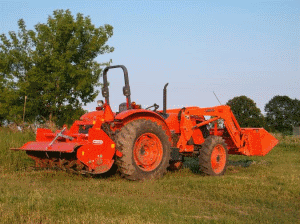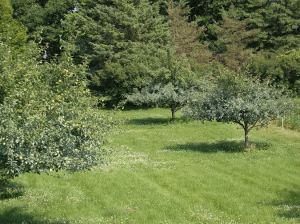By Joseph Dittman of Wild Ridge Farm
If the farmer paused briefly from his ceaseless toil, taking up pen and paper to list the various equipment he relies on continually in his daily labor, an afternoon would surely be lost and the farmer would retire to bed with cramps in his writing hand. Roller tables, harvest crates, wash tubs, pruners, hand hoes, soil knives, drip tape, row cover, lay flat hose, pitch forks, spades, backpack sprayers—hundreds of simple tools and supplies cluttering the dusty corners of barns and sheds. Tractors, rotary tillers, disc harrows, grain drills, box blades, wood chippers, log splitters, cultivators, cultipackers, flatbed trucks, skid loaders—the imposing diesel guzzlers and implements lined up in garages and parkways.
 While I can assure you that hundreds of those simple tools and supplies can make as big an economic impact as a single big-ticket items, still, tractors have captured our agricultural imagination and are the heroes of children’s books and the pride of weathered old planters and harvesters. In or last century, the scale of farming in America has been transformed to favor 1000-plus acre plots which necessitate fleets of powerful tractors and mammoth machines.
While I can assure you that hundreds of those simple tools and supplies can make as big an economic impact as a single big-ticket items, still, tractors have captured our agricultural imagination and are the heroes of children’s books and the pride of weathered old planters and harvesters. In or last century, the scale of farming in America has been transformed to favor 1000-plus acre plots which necessitate fleets of powerful tractors and mammoth machines.
But I am not against tractors. We at Wild Ridge love our Kubota M6040. An amazing machine, equipped with quick-attach front loader and class 2, three-point hitch, this orange darling does it all.
Our entire field layout and crop plan is designed with the Kubota in mind and all the beds are calibrated to its wheel width. This is the tractor we wanted. This is the tractor that gets the job done. Unfortunately, profit margins are tight in farming, and oftentimes the ideal piece of equipment exceeds the limited budget, forcing the farmer to improvise with what’s already on hand.
In the spring, Wild Ridge Farm was asked to take over stewardship of a small off-site apple orchard, but the budget had already been fixed the previous fall, and we had virtually no wiggle room to invest in extra equipment on a project with no sure financial return. Nevertheless, I thrilled at the prospect of orcharding. Apples have been a lifelong interest. In one of my earliest childhood memories, my mother, my older brother, and I—a venturesome 4 year-old—hike into our neighbor’s 10-acre field of wild flowers and prairie toward a solitary apple tree, standing tall above the grasses, to pick ripe apples. Thus, though we had neither the budget, nor the proper equipment, we said yes to stewarding fifty some odd trees on a 3-acre plot.
 On a cool early evening in late May, after a full day of work in the field, I courageously filled my little 3-gallon backpack sprayer with water and MicroSulf and began my first orchard task of apple scab prevention. Trudging from tree to tree with 30 pounds of water strapped to my back, I quickly realized I hadn’t the time nor energy to spray even as small an orchard as fifty trees with only a manually pumped backpack sprayer, and so, with much regret, I narrowed my focus to a block of the dozen most promising trees and let the others go natural for the year. But even with less trees to manage, the backpack sprayer fails in another aspect: it doesn’t spray high enough into trees that have been left un-pruned for several years with upper canopies as tall as twenty feet.
On a cool early evening in late May, after a full day of work in the field, I courageously filled my little 3-gallon backpack sprayer with water and MicroSulf and began my first orchard task of apple scab prevention. Trudging from tree to tree with 30 pounds of water strapped to my back, I quickly realized I hadn’t the time nor energy to spray even as small an orchard as fifty trees with only a manually pumped backpack sprayer, and so, with much regret, I narrowed my focus to a block of the dozen most promising trees and let the others go natural for the year. But even with less trees to manage, the backpack sprayer fails in another aspect: it doesn’t spray high enough into trees that have been left un-pruned for several years with upper canopies as tall as twenty feet.
Though it causes some embarrassment to show these ridiculous pictures of trees only half-covered in kaolin clay, I felt it an apt illustration of the consequences of using equipment inadequate for the task at hand.
Such goes the season: small victories and small defeats. Patiently we wait for that providential piece of useful equipment—some gift inherited from an older, wiser, or more experienced generation. Patiently we wait for the timely capital which will turn the tide of work in our favor.